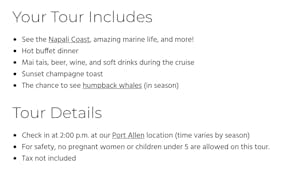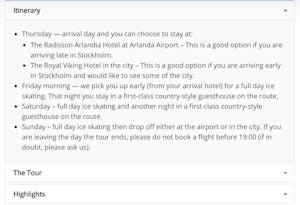- Dashboard & FareHarbor
- SEO
- Websites
Checklist: Tips for Writing Item Descriptions & Activity Pages
All Skill Levels
Join hundreds of other operators and REGISTER NOW for Spark 2024 New Orleans October 13-15th!

You know that the experiences you provide are fun, exciting, and memorable —but your potential customers won’t unless you write an impactful tour description that compels them to hit that book button.
Writing a tour description is not just about listing out your itinerary and meeting location. It’s your opportunity to rank for keywords specific to your location and activities, and boost your conversion rate by sharing the right information.
This guide will show you how to write a flawless tour description that is sure to increase your bookings.
Whether you’re starting from scratch, adding a new item to your Dashboard, or updating your existing descriptions, follow these tips to optimize your activities for SEO and conversions.
Before you start writing, conduct keyword research to discover the types of queries your customers use to find your business. Make sure the keywords flow naturally within your description and avoid keyword stuffing.
 Pro tip: If you are unsure if you are using keywords appropriately, read the sentence out loud to yourself. If there are a lot of redundancies or it sounds “off” to your ear, cut something out.
Pro tip: If you are unsure if you are using keywords appropriately, read the sentence out loud to yourself. If there are a lot of redundancies or it sounds “off” to your ear, cut something out.
It’s not enough to simply add keywords to a page to help it rank, you also must consider search intent. Essentially, you want your keywords to be specific and capture your customers at the right time in their booking journey.
 2. Write for a Specific Audience
2. Write for a Specific Audience A successful marketing strategy boils down to crafting the right message for the right audience — and this is no different for your descriptions. Ask yourself:
Consider the questions your past guests have asked, and make sure to answer them in your description. For example, a high-intensity tour that is geared toward adventurers should use language that speaks to the excitement and adrenaline of the experience.
On the other hand, a family-friendly tour should answer the parents’ questions – such as ideal age or any age limitations, what kids will learn, as well as any safety precautions or waivers required.
Customers may not read the entire tour description, so your first couple of sentences should cover all essential details. Start your description with a brief summary that hits on all the highlights of your tour, then go into more detail in the following paragraphs.
Let’s take a look at some examples of the first sentence in a tour description.
“Our tour begins at the marina, where you board the boat and meet the crew before we embark on our private boat tour.“
You might be tempted to describe your tour chronologically, starting with the meeting point, but this is not the most exciting part of your tour. If a reader only skims the first sentences, it’s unlikely to grab their attention. A better description would be:
“Discover all the most beautiful views of Hilton Head on this private boat tour that shows you the beaches, wildlife, and landmarks that make this one of the most breathtaking areas in the U.S.“
Once the reader is engaged, dive into more details about your tour in the following paragraphs.

Following the tour’s description, take the time to expand on tour details and answer common questions, such as:
A big block of text is unpleasant to the eye, so make sure you break up this information using bullet points, sub-headings, and sectioned content. For example, after you have provided essential information about the tour, then list out logistical information using bullet points (see Tour Details in the above example).

Instead of only focusing on logistics or the itinerary, tell the tale of what the tour experience will be like. For example, if you offer a relaxing boat tour, be sure to set the tone with details like “lounging on the deck” or “taking a refreshing swim”.
If you offer a food tour that visits local spots, don’t just tell readers they will “taste local food”, but rather “delight in the local flavors and discover what makes this city unique through its food.”
 Pro tip: Use the second person (“you” and “your”) to put the reader right into the action – imagining themselves in the experience. Avoid using cliches or overused language about tours. Instead, get specific and descriptive, using language that speaks to what’s unique about your location and your experiences.
Pro tip: Use the second person (“you” and “your”) to put the reader right into the action – imagining themselves in the experience. Avoid using cliches or overused language about tours. Instead, get specific and descriptive, using language that speaks to what’s unique about your location and your experiences.
It’s likely that potential customers are considering multiple companies before they decide to book their tour, so use your description to highlight what makes your tour different.
 7. Leave Some Surprises
7. Leave Some Surprises You must provide readers with enough information on what to expect on your tour, but you don’t need to divulge all the tricks you have up your sleeve.
For example, if you offer a walking tour of the city, let customers know about the most popular attractions they will see, but don’t divulge your full route or secret spots. Provide an overview that includes some of the highlights, and leave readers wanting more by telling them that you’ll take them to hidden gems and off-the-beaten-path stops along the way.
According to Google, their algorithm focuses more on content quality and relevance than it does on length.
Ultimately, your description should answer all customer questions and meet their search intent. So rather than worrying about the word count, just be sure to provide all the important information in a concise manner.
 9. Use Internal Links
9. Use Internal Links Make it easy for users to navigate between your activities by using internal links (links that point to other pages on your website). For example, if you offer a meat-heavy food tour that can’t easily be adapted to vegetarians, you can include a link in your description that takes users to a more veggie-friendly tour that would appeal more to their interests.
Perhaps the most important step! Once you’re done writing your tour description, you don’t want to be derailed by pesky typos. Take the time to proofread your work to catch any mistakes and publish a polished description. You can use a free browser extension like Grammarly to help you catch any errors.
Whether you are writing for new offerings or want to give your current one’s a refresh, engaging descriptions will bring more customers to your site and help boost your revenue.